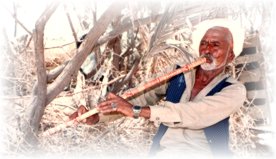|
Traditionally the Narr and its music are associated with love unhappiness and partition. Thus, Sindhi folklore attributes the origin of Narr to the love of Zulekha for Yusuf. While thirst for Yusuf, Zulekha used to perform ablution for prayer and from the water that collected from the kangore reed from which the Narr was produced. Shams of Tabrez, according to the traditional lore, were the painful and none would come near him, he took retreat in a private wood. The wind energetic through the fallen kangore stalks produced sweet tunes and when Shams heard them he took the reed and began to play it for comfort and support. Hence, the deep sadness intrinsic in the music of Narr.

According to yet another tradition, the wretched music of Narr is suitable to its trials and problems. The mother reed grows a team of stalks which stand together for a long time as virgin sisters closely associated in their natural beauty and environment. As one of the stalks attains it full growth, its trails and tribulations begin. It is scratch and is divided forever from its attendant. It is shorn off its green leaves and is uninterested from inside at the joints and hollowed. It is then, wrapped into rags which are overcooked in slow fire leaving red scars all over the reed. Holes are finally pierced into its body with a red hot iron bar. All this is done to the lovely green reed stalk which was once shaking and dancing with its companions. It suffers in order to sing. The separation which is made more sensitive by the cuts and fires is, as the tradition goes, responsible for the Narr's depressed melodies. This tradition is epitomized by Rumi and Shah Abdul Latif in their memorable verses. Says Rumi in the opening verse of the Mathnavi:
Listen to the Nai what story it's telling
Of the pangs of separation it's complaining.
Says Shah Abdul Latif:
As the reed cries aloud while suffering in pain
So is heart afflicted in love's strain.
Such a impression of the instrument's miserable back ground has given its music a special importance. Throughout Sind, the Narr is known as the ‘Lover's flute'. Among the village folk, the sweet melodies of Narr have brought many lovers together. The spirit of its music lies in its two basic varieties: The phook which is thought to be the ‘lover's call' to the beloved, and the Gur which is the ‘poetic expression of feeling of love'?
In its structure, Narr is the simplest type of blowing instrument and yet most difficult to play. It is just a piece of hollowed reed with four equip-distant holes pie reed towards the tail end and about 2 to 3 feet long. It is open at the both ends in its natural form, without any trick for blowing into it. No sound is produced if one blows straight into it. The player has to blow into it somewhat horizontally, most of the most end of the instrument remaining open without being pressed or closed by the lips.

The standard Nai instrument played in Turkey and some parts of Iran has six holes which provide for greater flexibility in changeable the music notes. The Sindhi Narr has only four and therefore, it requires greater skill to manipulate musical notes on it.
In Kutch, Narr or Kani is not so familiar to the public as there are only 3 performers of it at the moment, and they play only on some religious occasions, fairs and festivals. One of the master maestros of Kani was late Isak Chinki Fakir-70 year who just passed away in short illness. Isak Fakir stated the author in an interview that there was grand master of Kani late Laxman Rabari in a village named Bhadaro of Abdasa Taluka. Laxman Rabari was such a grand maestro of Kani that when he was playing Kani for hours continuously and many snakes gathered around him to enjoy his performance and village assemble also enjoyed hearing of Kani for hours. Isak Fakir witnessed this incident long year back and he found the idea of learning Kani. Since then, Isak Fakir learnt to play Kani for his own enjoyment. And he also learnt to make a Kani. In past, Kani was famous in Jat, Rabari and Thakarai community in Kutch. As the number of Kani players is limited to 3 persons, the number of Kani maker is also limited. At the moment, there are only 3 persons who can play and can make Kani in Kutch. The art of Kani playing is now on the way of ending. Kani makers put creative design on it and dye it with fine red colour when the bamboo of Kani is soft. A Kani needs 7 hollowed parts and 6 knots to prepare. And there are 4 holes on it to tune.
At present, the condition of Kani players and makers is so weak and admirable that any organization should do something to protect the dying of Kani.
|